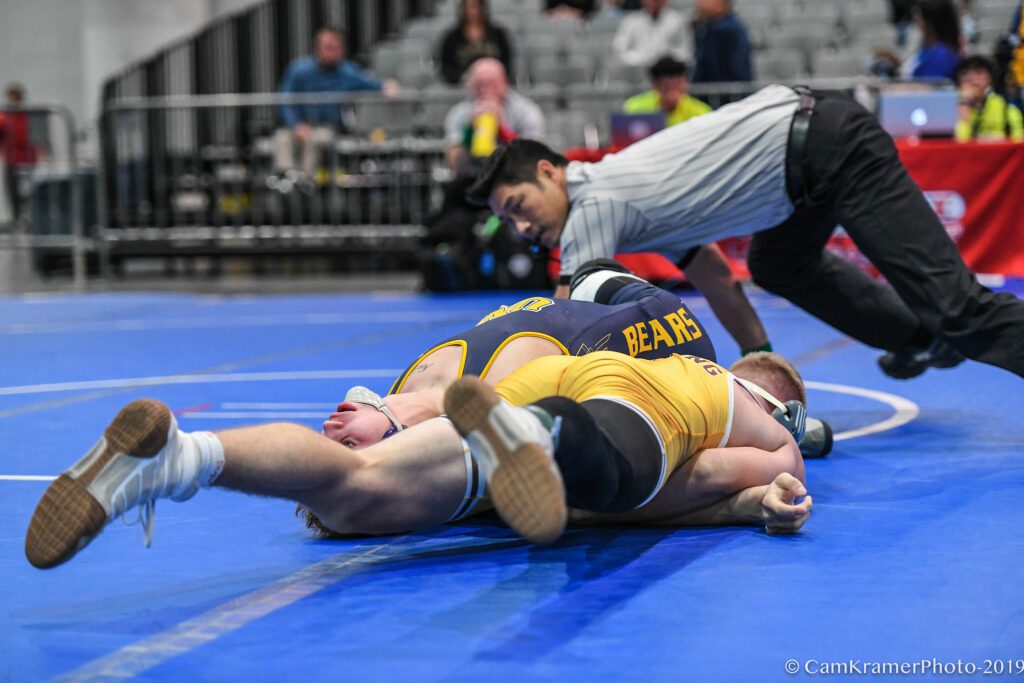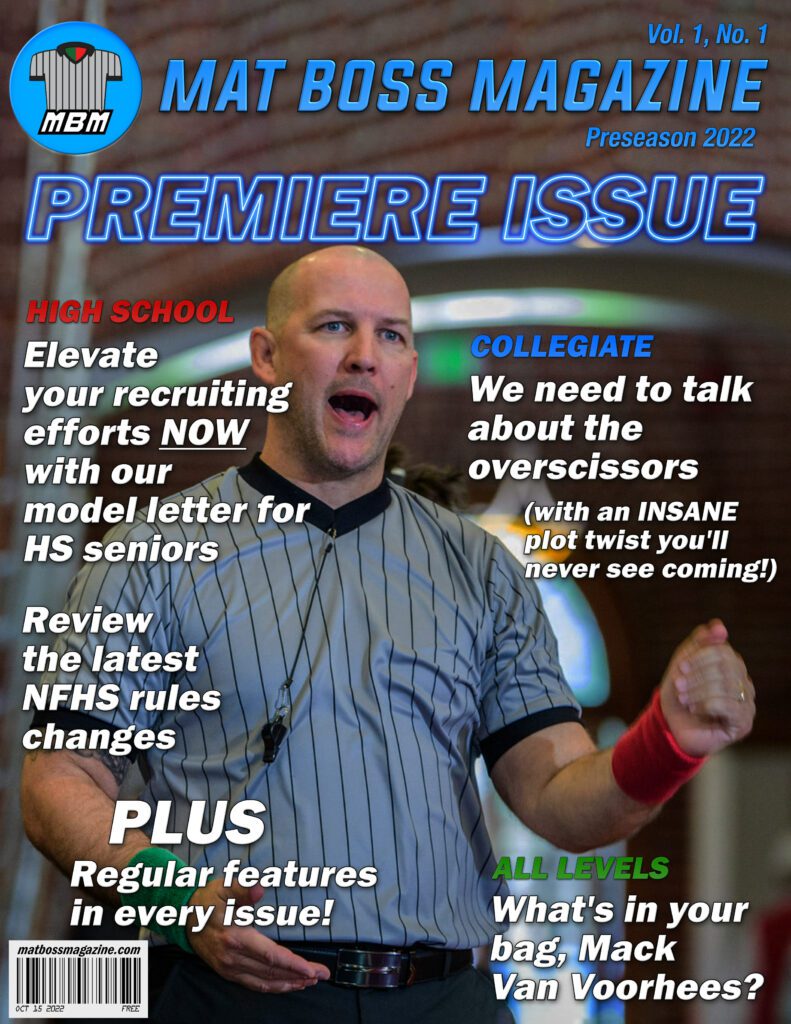First of all, we want your letters. Feedback. Questions about MBM. Questions about officiating. Send them to us.
Having said that, nobody really knew they could send anything to us because they didn’t know we existed, so we don’t have any actual reader mail for this issue. Therefore, while you’re getting the ball rolling with those letters, we will get the ball rolling with a few simulated letters. Look, here’s one now!
Be a better pro: Get to know Flo (and Track)
 Hello,
Hello,
First of all, I love your groundbreaking magazine. I’m a huge fan.
I wanted to ask you about the Flowrestling and Trackwrestling scoring systems. As an official, should I take the time to learn how they work in case an inexperienced or unprepared table worker needs help?
–Steven Rauser, Wisconsin
Dear Steven,
That’s a bit of a “softball question,” but no matter. The answer is yes.
Consider the following:
You can take ten easy, stress-free minutes now to learn the basics of the software, or you can stand there helplessly for all of those super-tense, awkward delays in your matches while you wait for the head table to send tech support to fix the tangled web of scoring mistakes just made by your table worker who “never actually used Flo” before the start of this event and “didn’t get a chance” to watch the training video. It is now 8:45 a.m., you are currently just six matches into a long day and your table worker is literally having a panic attack while everyone present stares at the two of you impatiently while you look around like, “Hey, it’s not my fault, I don’t technically have to learn that.”
Well, all those people are probably going to think that you’re incompetent anyway because you seem so totally ineffective about something so closely connected to your job. Of course, you could have a free opportunity here to impress everyone by immediately fixing the issue yourself like the professional you say you want to be. This kind of thing is the polish that pros have. Don’t be a schlub. The knowledge you need to become fluent in Flo or Track’s basic functionality can be gleaned from a single, short YouTube video.
 Here — we’ve assembled all the training videos for Flo and Track that you could possibly need. None are more than 14 minutes in length. Why don’t you take 15 minutes to watch one while you’re sitting around waiting for your next tournament to begin? (One training video is still way better than none.)
Here — we’ve assembled all the training videos for Flo and Track that you could possibly need. None are more than 14 minutes in length. Why don’t you take 15 minutes to watch one while you’re sitting around waiting for your next tournament to begin? (One training video is still way better than none.)
Keeping track of choice
Hello,
Right off the bat, I want to say that I’ve been waiting for this kind of magazine forever! You’re the greatest.
What is a good system to use in order to keep track of which wrestler has choice of position (in both the second and the third periods) in tournaments and dual meets?
–Will Phillips, North Carolina
Dear Will,
Even if it wasn’t technically your responsibility to do (it is technically your responsibility though), relying on anyone else to keep track of choice is a valid optics concern. (Spectator: “He doesn’t even know who has choice. How closely could he possibly be paying attention to the match?”) You should always endeavor to mimimize or eliminate these kinds of optics concerns whenever possible.
Here is the complete system for tracking choice of position that Mack uses:
 Individual Tournaments: Single flip disc only. Nothing special. Discs with any number of sides will settle on the mat far more gracefully than discs with a rounded edge such as a circle. Among discs with sides, those with an odd number of sides (e.g., septagon) will typically settle slightly more easily than those having an even number of sides (e.g., hexagon, octagon), but this is a triviality; a disc with an even number of sides is fine. Your pants must have two back pockets, one on each side.1You don’t want to look like you’re constantly fiddling with your junk just so that you can ascertain who has choice. Side pockets are not graceful for this purpose, so do not use side pockets. The disc goes in either one of the back pockets.
Individual Tournaments: Single flip disc only. Nothing special. Discs with any number of sides will settle on the mat far more gracefully than discs with a rounded edge such as a circle. Among discs with sides, those with an odd number of sides (e.g., septagon) will typically settle slightly more easily than those having an even number of sides (e.g., hexagon, octagon), but this is a triviality; a disc with an even number of sides is fine. Your pants must have two back pockets, one on each side.1You don’t want to look like you’re constantly fiddling with your junk just so that you can ascertain who has choice. Side pockets are not graceful for this purpose, so do not use side pockets. The disc goes in either one of the back pockets.
After the end of the first period,2Do not have the disc out, be retrieving the disc, or flip the disc before the period has actually expired. It may save you a second or two, but it invites the kind of complacency that could catch you unfocused at the wrong moment, with ugly results. flip the disc, allowing it to hit the mat. Do not ever catch the disc; I do not care how fat or old or injured you are, this is not acceptable ever, under any circumstances. If the disc happens to contact another wrestler’s foot or something before it settles, that is fine; you do not need to reflip it. When the disc has settled, leave it there for now; do not pick it up.
Extend your arm overhead, fingers together, open palm, on the side that has choice. I actually point to the wrestler with my index finger on that hand immediately before extending that arm up overhead (if straight up is 90 degrees, I place my arm at around 65 or 70 degrees). The reason for this is to get the attention of the wrestler as quickly as possible, and of course so everyone knows which wrestler you need input from first in order to proceed. The pointing is also a mechanism to self-verify that I am actually pointing at and asking for choice the wrestler who is, in fact, green (or red, as the case may be). It also connects everyone with why you have suddenly raised that arm overhead.3There is technically no approved set of signals for much of the choice of position sequence, so there may be some minor stylistic differences among officials here. I believe this approach best minimizes the potential for confusion and/or mistakes, but these precise mechanics are not necessarily required by any particular rule.
“Green, it’s your choice.” You do not need to provide them with a list of what those potential choices are; if they don’t know that, they should be looking to their coach, anyway. At the youth level, if the wrestler looks confused when I ask them for choice, I will typically prompt them to look at their coach (if I am not already looking to their coach anyway for the choice).
Make sure there is no ambiguity in their choice. At the collegiate level, we are instructed to get verbal confirmation of this, but at other levels, this is not necessary so long as you are sure that both of you are on the same wavelength.
Green defers. You signal this (using the correct defer signal, which is not making an “X” in front of you with your wrists) and raise the other arm in the same way. The defer signal actually flows very nicely here, while you say
“Green defers to red. Red, your choice.”
Red indicates bottom. You will signal this (please do not use a closed fist and thumb to do so, it looks amateurish), then, as the wrestlers are getting set, pick up the disc and place it in your back pocket on the side with the wristband that corresponds to the color of the wrestler who will have choice in the third period.
At the end of the second period, if you have forgotten who has choice in the third, you can simply brush your hands against your back pockets, which will instantly tell you which side the disc is on (and thus which wrestler has choice in the third period). This is a very natural motion that will go entirely unnoticed.
DON’T use the disc as a communication prop, as though nobody could possibly understand whether you’re referring to green or red without having that side of the disc held up in front of you. In fact, you may have noticed that we already wear a wristband on each wrist for this very purpose. I have seen officials who pick up the disc and, like, flip it around when one wrestler defers to the other, as if they were a magician doing sleight-of-hand with the disc or something. It looks silly, but even more importantly, it is not how we (to introduce an expression that I will probably use routinely in this magazine) “officiate with purpose.”
 By this, I mean that everything we do on the mat, down to the smallest detail, needs to have some deliberate thinking and choice-making behind it (i.e., option A instead of options B, C, D, etc.). We should always be trying to optimize our own methods, and an official cannot realistically expect to do that if they don’t even know why they’re doing things the way they currently are, or what alternative techniques might be available that could allow them to enhance some aspect of their officiating. When you start giving this kind of comprehensive and nuanced consideration to everything you’re doing out on the mat, you’ll know you have started down the path to officiating with purpose.
By this, I mean that everything we do on the mat, down to the smallest detail, needs to have some deliberate thinking and choice-making behind it (i.e., option A instead of options B, C, D, etc.). We should always be trying to optimize our own methods, and an official cannot realistically expect to do that if they don’t even know why they’re doing things the way they currently are, or what alternative techniques might be available that could allow them to enhance some aspect of their officiating. When you start giving this kind of comprehensive and nuanced consideration to everything you’re doing out on the mat, you’ll know you have started down the path to officiating with purpose.
To be continued…in the next issue!



